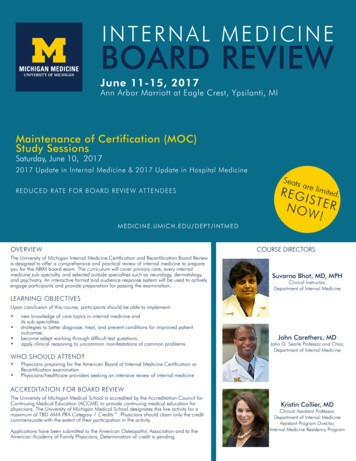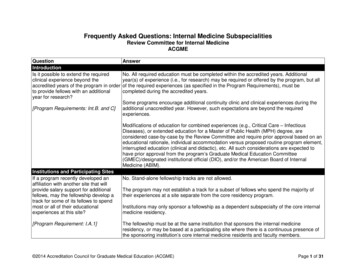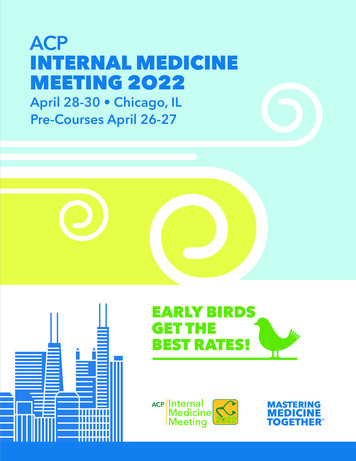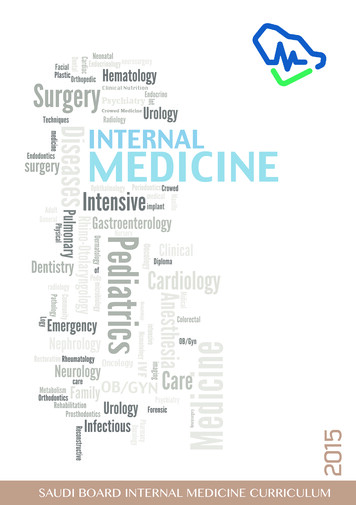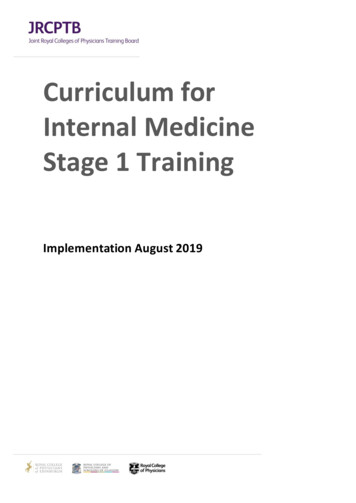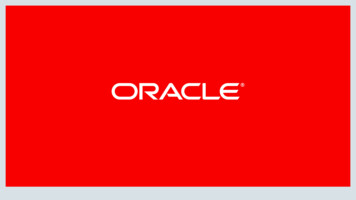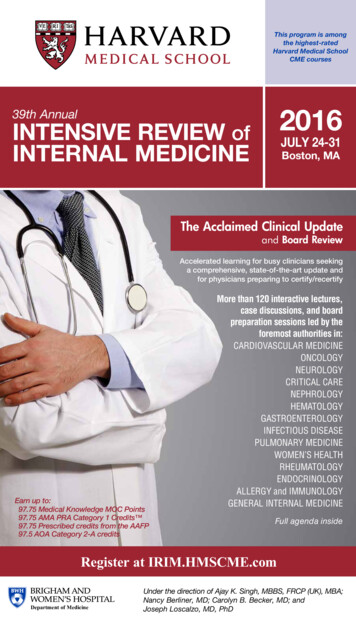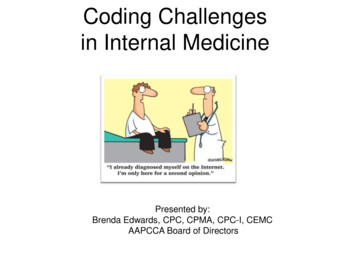
Transcription
Coding Challengesin Internal MedicinePresented by:Brenda Edwards, CPC, CPMA, CPC-I, CEMCAAPCCA Board of Directors
Topics to Discuss 2Medical necessityBulletproof E/M documentationCerumen removalSkin proceduresJoint injectionsDrug administrationCarve out visitsIncident toGrey Areas
E/M Code Selection & Medical Necessity Is equal to the sum of:1. HistoryPlus2. ExamPlus3. Medical Decision Making (MDM)Together equalThe E/M Code Selection
E/M Code Selection Medical necessity– “Medical necessity of a service is the overarchingcriterion for payment in addition to the individualrequirements of a CPT code” Volume– Should not be the primary factor to select the level ofservice billed Documentation– Accurately support the level of service 04c12.pdf
E/M Code SelectionHistory Problem Expanded DetailedFocusedComprehensiveExamProblem Expanded DetailedFocusedComprehensiveMDMStraight LowForwardModerate High
E/M Code SelectionHistory Problem Expanded DetailedFocusedComprehensiveExamProblem Expanded DetailedFocusedComprehensiveMDMStraight LowForwardModerate High
Bulletproofing E/M Documentation77
Questions to Ponder How do we achieve “bulletproof E/Mdocumentation? Would another provider be able to step in? Would documentation be specific and legible? Would another provider understand the rationalefor treatment? In the worst case scenario, if a provider is in a courtof law, would they be able to defend theirdocumentation?8
Bulletproofing E/M Documentation Make the Chief Complaint areal complaint–Chief complaint is not 3 month follow upHere for check upDoing wellAnkle
Answer the Questions Who- is the patient? What – is the problem? When – did it begin?(Set date or chronic?) Where – is the location of the problem? Why – is the patient here? How –are you going to treat them10
Don’t ignore the ROS Avoid pitfalls in ROS– Providers should identify each systemreviewed– Avoid vague language– ROS as above– ROS within normal limits– ROS negative All others negative(We’ll address this in grey areas)11
Use the Exam Guidelines WhichWork Best for Your Provider You CAN use either 95 or 97guidelines just don’t combine themon one visit Physician’s are not limited byspecialty on the 97 exam templates12
Incorporate the Language ofMDM into the Documentation Use language that paints thepicture, give rich details of theencounter13
Cerumen Removal Considerations––––Visual-exam impaired?Qualitative-causing symptoms?Inflammatory-foul odor or infection?Quantitative-obstructive, copious? Additional Considerations– Simply removing wax is not 69210 Instead use appropriate level evaluation and management (E/M)code regardless of how it is removed– Only the provider can bill 69210 for removal if truly impacted Using at minimum an otoscope and instruments such as waxcurettes and suction plus specific ear instruments (eg, cup forceps,right angles) Indicate the time, effort, and equipment required14
Cerumen Removal Separate E/M with modifier 25 to identify significant andseparately identifiable problem was addressed during visit 69210 Removal impacted CERUMEN (separateprocedure), 1 or both ears G0268 Removal of impacted CERUMEN (one or bothears) by physician on same date of service as audiologicfunction testing– Add on code stating both the removal of CERUMEN and functiontesting were performed.– Used for Medicare services15
Cerumen RemovalWhich scenario(s) are reported with 69210?1) The removal is performed by the nurse via irrigationor lavage.2) The removal is performed by the primary carephysician via irrigation or lavage.3) The “ear wax” is described as impacted cerumenbecause it completely covers the eardrum and thepatient has hearing loss. The impacted cerumen isremoved by the primary care physician orotolaryngologist with magnification provided by anotoscope or operating microscope and instrumentssuch as wax curettes, forceps, and suction.16NO!NO!YES!
Cerumen Removal Example A 43-year-old female presents with flu and respiratory symptoms,including nasal drainage and ear congestion as well as a cough. Onexam, the physician finds impacted cerumen obstructing the lefteardrum. Impacted cerumen is removed and prescriptions givenfor cough and congestion.COMPARED WITH 17On exam, the physician finds impacted cerumen completelycovering the left eardrum resulting in hearing loss. The impactedcerumen is removed by the primary care physician withmagnification provided by an otoscope, forceps and suction.
Skin ProceduresThe physician documents an excisional shavebiopsy of the forearmHOW DO YOU CODE THAT?18
Skin Procedures Paring or Cutting 11055-11057 (0 global days)– Removal by peeling or shaving– Used for corns or calluses Biopsy 11100-11101 (0 global days)– Removal or entire or partial lesion to confirm a diagnosis– Biopsy is content when done on same lesion/same day Removal 11200-11201 (10 day global)– Removal by sharp method or destruction– Small flesh-colored/pigmented lesions around neck, upper chest,axilla, groin Shave 11300-11313 (10 day global)– Sharp removal of dermal or epidermal lesions without fullthickness excision– Does not require suture closure19
Skin Procedures-Excision Benign 11400-11446 (10 day global) Malignant 11600-11646 (10 day global)– Documentation must include Diameter of lesion, including margins required for completeexcision– Should be done PRIOR to removal-don’t rely on path report– Specimen may shrink or become fragmented duringexcision Location and quantity of lesions removed– Sutures Simple (non layered) closure is included in excision Intermediate or complex is separately reportable– Wait for pathology report to assign correct CPT code20
Skin Procedures-Destruction Benign 17000-17004 (10 day global)––––17110-17111 (common/plantar warts)Code selection by number of lesions, not methodDoes not require suturesMethod Electrosurgery, cryosurgery, laser, chemical treatment Malignant 17260-17286 (10 day global)– Code based on location AND size of each lesion– Does not require sutures– Method Electrosurgery, cryosurgery, laser, chemical treatment21
Skin Procedures Before assigning the lowest code in a range–Query physician–Look at CPT , CDR and any other resources together “CPT descriptions are not the same as what youare telling me” “Help me to understand what you did or what youmeant”22
Example The patient is a 39-year-old male with history of asuspicious mole on the left upper arm which wasrecently biopsied and indicated actinic keratosis. Todaywe are excising the remainder of the lesion (in ASCsetting). After injecting 15 cc of 1% Lidocaine around thearea of the keratosis, the skin was incised in a 1.5 cmelliptical fashion and down through the subcutaneoustissue. The subcutaneous tissue was then closed with 30 absorbable suture. The skin was closed with threesutures and dressing applied. The specimen wassubmitted to Pathology. The patient will return in twoweeks for suture removal.231140212031 (51 not applicable in ASC or hospital setting)
Superficial Incisionand Drainage Location Size Global period24
Superficial Incisionand Drainage 10060/10061 Incision through the skin to allowabscess contents to drain– Superficial and not deeper structures. “Complicated“––––Indicates site was difficult to accessRequired prolonged physician workDrain may be placed with closure at a later dateDocument the complicating factor 10 day global25
Example 54-year-old female is seen with a complaint of a painfullump on the middle of her back. It has been warmrecently and in the past has drained (like a pimple) whenpressure was applied. It has come back twice now afterbeing popped. Examination reveals a quite raised,red area in the bra line area of her back. Thisappears to be a sebaceous cyst which has drained inthe past. An incision is made and the cyst is allowedto drain. We will take a look at it in 10 days to seehow it is healingOR2610060 for single cyst
Example 54-year-old female is seen with a complaint of a painfullump on the middle of her back. It has been warmrecently and in the past has drained (like a pimple) whenpressure was applied. It has come back twice now afterbeing popped. Examination reveals a quite raised,red area in the bra line area of her back. Thisappears to be a sebaceous cyst which has drained inthe past. I recommended we remove it to avoidproblems in the future. An incision is made and thecyst and capsule are removed intact. A simpleclosure was performed. Patient to follow up in 10days for suture removal.Need size of the defect created to determine the excision code (11400-11443)27 Simple closure is included
Joint Injections Size of joint (0 global days)– 20600 small (finger, toe)– 20605 medium (wrist, elbow, ankle)– 20610 major (shoulder, hip, knee joint) Injected or aspirated?– What if the same joint is injected and aspirated?– What if the plan is to aspirate and inject but no fluid isremoved? Drugs injected– Name(s) and dosage(s) (multiply out units) Office visit only when significant and separately identifiable Modifiers- 2528- 50- 51- 59
Example Established patient presents with ten day historyof painful right knee. She fell playing softballand slid on both knees. No open wounds notedon either knee. Vitals 128/78, pulse 80. Uponexamination of the right knee, a fluid collection isfelt on the inner aspect of the knee. The plan isto aspirate the fluid and inject Depo Medrol.This should relieve the swelling and pain in theknee.Does documentation support a separate visit?2920610, in addition a HCPCS code for depo medrolIs there a problem with the note? No dosage!
Drug Administration Allergy injections 95115-95199– John comes in weekly for his allergy shot Immunization Administration 90465-90474– Bill in addition to the vaccine and toxoid codes 90476-90749 Therapeutic/diagnostic or antibiotic type ofinjection 96360-96379– Name of drug being injected– Route of administration (i.e., subcutaneous, intramuscular, intraarterial or intravenous)– Dosage30
Drug Administration Office visit may be separately billable only if "otheridentifiable services are provided at that time” Medicare will not allow CPT code 99211 on the sameday as a drug administration code that has a workrelative value unit"– Only allowed with modifier 25 indicating that a separatelyidentifiable evaluation and management service was OTN.pdfMedicare Pub. 100-20 transmittal 3431
Carve Out Is it possible? SURE!– A physician can provide both a preventive and aproblem-focused "sick visit" services at the same time Why do it?The intentThe “Oh By The Way” listSignificant separate service– Document what the provider actually did to treat chronicconditions If purely med check/refill, it is preventive Medication modifications due to symptoms may warrantseparate service Patient complaints32
Medicare Claims Processing Manual"When a physician furnishes a Medicarebeneficiary a covered visit at the sameplace and on the same occasion as anoncovered preventive medicine service(CPT codes 99381-99397), consider thecovered visit to be provided in lieu of apart of the preventive medicine service ofequal value to the visit”33
Carve Out-CPT-4 Documentation requirements– If an abnormality is encountered or a preexisting problem isaddressed in the process of performing this preventive medicineservice, and if the problem/abnormality is significant enough torequire additional work to perform the key components of aproblem-oriented E/M service, then the appropriateOffice/Outpatient code should also be reported The appropriatepreventive medicine service is additionally reported.– An insignificant or trivial problem that is encountered in theprocess of performing the preventive medicine service and whichdoes not require additional work and the performance of the keycomponents of a problem-oriented E/M service, should not bereported.34CPT Guidelines - Evaluation and Management, Preventive Medicine Services
Carve Out What part of the visit is preventive, which partwas illness/injury related?– Not required to have two separate notes but may behelpful documentation is separated in the visit– “Sick” visit will need the history, exam, medicaldecision-making for the problem documented Append modifier 25 to “sick” visit– Treatment of insignificant problems is included inpreventive service35
Carve Out-Medicare Preventive visit must be reported and “carved out” eventhough it is a non-covered service Medicare-covered screening services during the visit– Colon/rectal cancer screening (G0104-G0106, G0120G0122, 82270)– Prostate cancer screening (G0102, G0103)– Screening breast cancer mammography (77057, G0202)– Glaucoma screening exam (G0117, G0118)– Pap smear (Q0091)– Pelvic and breast exam (G0101)– Flu, pneumonia and hepatitis B vaccines(G0008, G0009 and ps guide web-061305.pdf
Carve Out-Medicare99397Preventive medicine (non covered)99214-25 ”Sick visit” E/M (covered by Medicare)Total chargesPatient responsibility 100.00-40.00140.0060.00 Patient can only be billed the difference between the standardfee for the preventive service(s) and the amount thatMedicare will cover Patient is responsible for co-insurance based on the Medicareallowable Patient is responsible for deductible37 The fees are for example only and do not correspond with the Medicare Fee Schedule
Example of Carve Out Physician sees an established patient fora scheduled annual exam (preventivemedicine) During the course of the encounter breastlumps are palpated. An order is written fora mammogram ASAP (problem focusedvisit)38
Incident To 39What is this?EstablishedWhere can this be billed?Who does this pertain to?Who is the supervising MD?DocumentationKnow your state lawsPayment
Incident To Employee of the physician Patient, problem and plan of care are all established– Physician must initiate course of treatment, provide subsequentservices on a frequency to show active participation and management Provided in the office setting under direct personal supervision ofphysician(in the office suite and immediately available)– Cannot be billed in the hospital setting Documentation must link the NPP (NPs, CNSs and PAs) with thesupervising physician– Legible co-signature of practitioner providing care and the supervisingphysician– Notation of supervising physician's involvement NPP service is paid at 100% of the physician fee40
Example A physician employed NP works in a satellite office. The physician isnever present. The physician evaluates a patient with diagnosis of hypertension.The physician initiates treatment and sees the patient every thirdvisit. The NP conducts follow-up visits with the patient, monitoringand treating the hypertension over weeks, months, or years.41
42
Using Same Elements for HPI and ROS“You would expect there to be some further developmentin the ROS," a senior CMS official says. “What youmay not do is use the same piece of information to scoretwice within the HPI, he adds”.Q6. Can a physician count a single history item in both the HPI andROS? For example, could we count "shortness of breath" as anassociated sign and symptom in the HPI and respiratory system in theROS?A 6. A clearly documented medical record would prevent the need to"double-dip" for HPI and ROS, but WPS Medicare, in rarecircumstances, could accept counting one statement in both areas ifnecessary.43 ources/provider types/2009 0526 emqahistory.shtml
Counting CC and HPI ElementsQ 22. Can the History of Present Illness (HPI) elements becounted for both the Chief Complaint (CC) and theassociated signs/symptoms? For instance, a patientpresents with chest (location) pain (CC) that she has had for3 days (duration). She also experiences shortness of breath(associated signs/symptoms) when walking up the stairs(context).A 22. Yes. According to the E/M 1995 and 1997 DG, "TheCC, ROS, and PFSH may be listed as separate elements ofhistory or they may be included in the description of thehistory of present illness44 ources/provider types/2009 0526 emqahistory.shtml
Review of Systems-“All Systems Negative”At least ten organ systems must be reviewed.Those systems with positive or pertinentnegative responses must be individuallydocumented. For the remaining systems, anotation indicating all other are negative ispermissible. In the absence of such a notation,at least ten systems must be individuallydocumented.45 1995 and 1997DOCUMENTATION GUIDELINES FOR EVALUATION & MANAGEMENT SERVICES
PFSH When Past, Family and/or Social History documentation has theterms "Non-contributory" or "negative," these are not consideredappropriate documentation. Documentation of PFSH must includesocial and/or family history information, such as alcoholconsumption, smoking history, occupation, or familial hereditaryconditions. When the terms "non-contributory" or "negative" are used in PFSHdocumentation, the documentation might indicate "Past medicalhistory is non-contributory" or "Social history is non-contributory."Such documentation would not indicate the provider had actuallyaddressed the issues. It must be clear that the PFSH was discussedwith the patient. To use the term "non-contributory" alone does notclearly indicate PFSH was addressed.46http://www.wpsmedicare.com/part b/publications/em history.shtml
Use of 3 Chronic Conditions as HPIQ 7. Where can I get CMS' documentation stating threechronic or inactive conditions apply to both 95 and 97guidelines?A 7. The 1997 DG state an extended HPI consists of atleast four elements of the HPI or the status of at leastthree chronic or inactive conditions. The 1995 DG do nothave this statement. However, WPS Medicare receivedclarification from CMS indicating this statement appliesto both 1995 and ing/resources/provider types/2009 0526 emqahistory.shtml
Use of 3 Chronic Conditions as HPI In 1997 the Evaluation and Management (E/M)Guidelines were enhanced under the History of PresentIllness (HPI) section of the 1995 score sheet to includepatient's chronic conditions in which an exacerbationmay have occurred resulting in the chief complaint andthe reason for the patient encounter. The documentationin the patient's medical record must state a status of thechronic condition in order to meet the requirement underthe History: HPI Status of 1, 2, or 3 Chronic Conditionson the 1995 score sheet. An example could be:hypertension - stable on m/faq/partb/pet/lpet-evaluation management services.html
Thank you!49
preventive medicine service is additionally reported. –An insignificant or trivial problem that is encountered in the process of performing the preventive medicine service and which does not require additional work and the performance of the key components o
